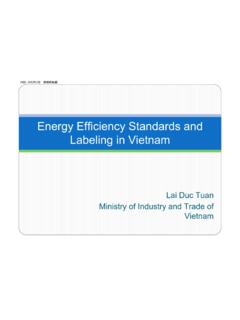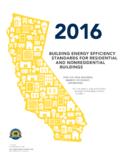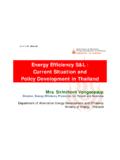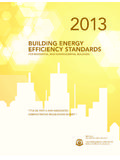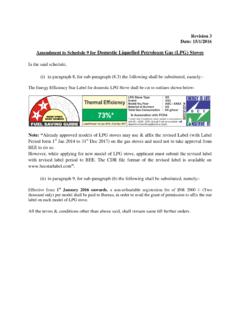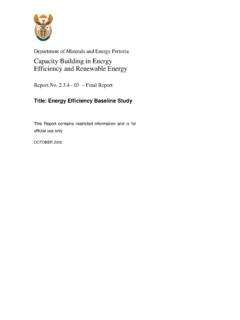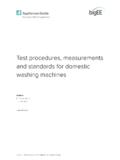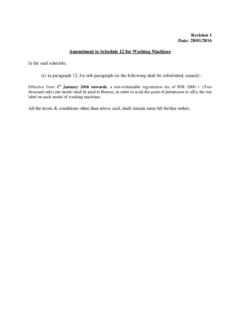Transcription of Regulation on Energy Efficiency Labeling and …
1 MKE s Notification 2010-124 Regulation on Energy Efficiency Labeling and standards 16 June 2010 Ministry of Knowledge Economy Korea Energy Management Corporation Remark: This translated English version is only for reference, it is not effective. 1 MKE(Ministry of Knowledge Economy) s Notification 2010-124 The revision notifies Regulation on Energy Efficiency Labeling and standards (MKE s Notification 2009-317, 28 Dec. 2009) based on the Act Chapter 15 and others of Rational Energy Utilization Act of Korea. 16 June 2010 The minister of knowledge economy (hereinafter MKE ) Regulation on Energy Efficiency Labeling and standards Enacted by MORE 1992-71, 17 Aug. 1992 Amended by MOCIE 1993-25, 1 Jun. 1993 Amended by MOCIE 1993-130, 7 Jan. 1993 Amended by MOTI 1995-125, 29 Dec. 1995 Amended by MOTI 1996-393, 18 Nov.
2 1996 Amended by MOCIE 1999-24, 8 Mar. 1999 Amended by MOCIE 2000-101, 23 Sep. 2000 Amended by MOCIE 2002-20, 16 Feb. 2002 Amended by MOCIE 2003-40, 14 May 2003 Amended by MOCIE 2003-88, 30 Dec. 2003 Amended by MOCIE 2004-37, 30 Mar. 2004 Amended by MOCIE 2005-50, 6 May 2005 Amended by MOCIE 2006-26, 13 Mar. 2006 Amended by MOCIE 2007-70, 25 May 2007 Amended by MOCIE 2007-149, 26 Dec. 2007 Amended by MKE 2008-99, 31 July 2008 Amended by MKE 2009-26, 10 Feb 2009 Amended by MKE 2009-158, 30 July 2009 Amended by MKE 2009-304, 11 Dec 2009 Amended by MKE 2009-317, 28 Dec 2009 Amended by MKE 2010-124, 16 June 2010 Note : MORE : Ministry of Resource and Energy MOTI : Ministry of Trade and Industry MOCIE : Ministry of commerce, industry and Energy Chapter 1. The general Article 1. (Purpose) The purpose of this Regulation is to define the Energy saving equipments and to regulate the monitoring program for the Energy saving equipments by the rational Energy utilization Act Chapter 15, 16, 24, 66, 68, and 69.
3 2 Article 2. (Scope) All related, target Energy performance standard, target Energy performance standard level, minimum Energy performance standards and minimum Energy performance level, Energy Efficiency , Energy consumption, Energy label, grade, test methods are defined in this Regulation except the export products. Article 3. (Definitions) For the purpose of this Regulation the definitions apply ; 1. Appliances with Energy Efficiency label : Appliances which have the high market penetration and much Energy consumption defined in Article 4 are adopted to save Energy by the Minister of MKE 2. Energy Efficiency : Energy Efficiency or Energy consumption which is measured as test procedures in this Regulation by Independent testing laboratories or self-certify testing laboratories qualified 3. Minimum Energy Performance standards (MEPS) : The standards are to promote and expand the high Energy Efficiency appliances in the case that the low Efficiency appliances can be limited to produce and sell.
4 4. Accomplishment ratio for MEPS : A ratio which measured Energy Efficiency as test procedure in this Regulation divides by MEPS. 5. Energy Efficiency Level : The rating (1st ~ 5th level) is granted that Energy Efficiency is measured as test procedure in this Regulation . 6. Model : Design or structure which many copies or reproduction are to be made by manufacturer or importer, and to report test results of each Model to KEMCO from manufacturer or importer. 7. Derivative Model : The model which has the same Energy Efficiency and the same Energy Efficiency level to the reported model but has different color, production date, and very slight change without performance difference. In a case of 3 phase induction motor, it is accepted if the rated output is between the leveled value. But, in the case that electrical or mechanical redesign is adopted, manufacturers or importers shall report as a new model.
5 8. Independent testing laboratories : The Minister of MKE designates the testing laboratory as Independent testing laboratories. 9. Self-certify testing laboratories : The Minister of MKE designates the manufactures or importer who can be qualified with the requirements as self-certify testing laboratories. 10. High Efficiency lamp : Fluorescent lamps, and Associated lamps obtain the 1st level of Energy Efficiency rating as according to this Regulation . But Fluorescent lamps ballasts shall be met with TEPS(Target Energy Performance Standard). 3 11. Rated Thermal Efficiency for heating : Energy Efficiency in household gas boiler is less than the heating thermal Efficiency (hereinafter Measured thermal Efficiency for heating ) measured by The Liquefied petroleum Gas safety and business management law Act Chapter 20, Article 4 or measured in the independent testing laboratory and shall be shown by manufacturers or importers.
6 12. Rated Thermal Efficiency for water heater : Energy Efficiency in household gas water heater is less than the water heating thermal Efficiency (hereinafter Measured thermal Efficiency for water heater ) measured by The Liquefied petroleum Gas safety and business management law Act Chapter 20, Article 4 or measured in the independent testing laboratory and shall be shown by manufacturers or importers. 13. Standby power : Power consumption by machinery and tools, when connected to the external power supply, while not performing their primary functions or while awaiting instructions to provide full services. Chapter 2. Scope, Items and Technical standards Article 4. (Scope, Items, and standards ) According to this Act Chapter 15, clause 1 and Chapter 7, clause 1, the scope, items, and technical standards are defined in followings (see Annex 1), and testing items, the number of testing samples, test standards , and the number of sample failed are defined in Annex 2.
7 1. Refrigerator Household electric refrigerator and refrigerator-freezer of storage volume 1000L or less with the cooling system of less 500W electric power consumption by KS C ISO 15502 Monthly electric power consumption shall be measured by the test method of KS C ISO 15502, where is defined as followings ; - Monthly electric power consumption = Measured power consumption x 365/12 2. Freezer Household electric freezer of storage volume 80L ~ 400L Monthly electric power consumption shall be measured by the test method of KS C ISO 15502, where is defined as followings ; - Monthly electric power consumption = Measured power consumption x 365/12 4 3. Kimchi Refrigerator Household electric refrigerating appliances of total storage volume 1000L or less, and Kimchi storage compartment is much than 50% of the whole storage volume with a function maturing which it will be able to take effect the foodstuffs of the Kimchi artificially, and with a compression type refrigerating machine and storage cabinet integrated in one body.
8 Monthly electric power consumption shall be measured by the test method of KS C 9321 4. Air-conditioner Air-conditioners of rated cooling power consumption of not more than 7,500W and the rated cooling capacity of not more than 23,000W If it has heater, the rated power consumption of heater shall be not more than 5,000W. Exclude water cooling, duct-type, portable, multi-split type Cooling Energy Efficiency Ratio (hereinafter EER) shall be measured by the test method of KS C 9306, which is obtained from the cooling capacity divided by the cooling power consumption. 5. Washing machine By KS C 9608 washing machine in which the textiles are substantially immersed in the washing water, the mechanical action being produced by a device moving, which are defined the agitator washing machine, and impeller washing machine with the rated capacity of 2 kg ~ 20kg But, washing only, spin extraction only and separated spin extraction are excluded.
9 Energy Efficiency shall be measured by the test method in Annex 1, which is obtained from Energy consumption (Wh) divided by the rated capacity (kg) in a specified cycle. 6. Horizontal drum washing machine Horizontal drum washing machine which is defined the household washing machine with the rated capacity of 2 kg ~ 20kg, and has the heater, spin extractor, and dryer. But, non-detergent type is excluded, and the type with the heater is only available to boil or to dry is also excluded. 5 Energy Efficiency shall be measured by the test method in Annex 1, which is obtained from Energy consumption (Wh) divided by the rated capacity (kg) in a specified cleaning cycle 7. Dishwasher By Annex 1 a machine which washes rinses, and dries (when drying process is include) dishware, glassware, cutlery and, in some cases, cooking utensils by chemical, mechanical and/or electrical means with the rated capacity 20 person or less.
10 Energy Efficiency shall be measured by the test method in Annex 1, which is obtained from total Energy Efficiency ratio (EERt) multiplied by electrical Energy Efficiency ratio (EERe) and water Energy Efficiency ratio (EERw). 8. Dish drier A machine which only dries dishware, glassware, cutlery and, in some cases, cooking utensils by electrical means with the rated capacity 10 person or less after washing, and has the top or front door or sliding door. Energy Efficiency shall be measured by the test method in Annex 1, which is obtained from Energy consumption (Wh) for 20 minutes divided by TEPS(Target Energy Performance Standard). 9. Electrical Cooler and Heater for Drinking-Water Storage By Annex 1 Electrical cooler and heater for drinking-water storage shall be designed the vapor-compressor cooler, heater, and water storage in a cabinet.


